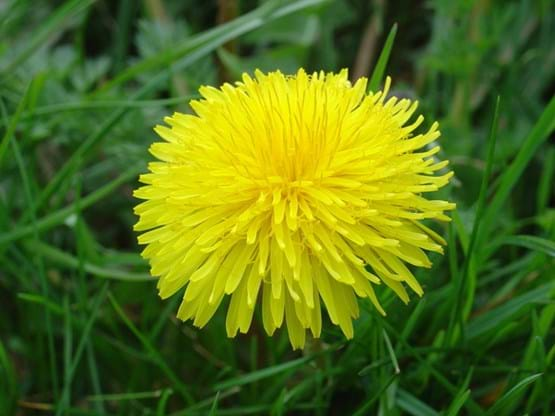Weed Control for Healthy Lawns and Gardens
It is unrealistic to think that we can have a garden or a lawn that is entirely weed free. We need to manage weeds so they don’t become an overwhelming problem. This means tolerating some weeds in some situations. If you really want to solve your weed problem, you will need to spend some time, have some patience, and expend some effort.
What is a weed?
A weed in the garden is usually a plant growing in the wrong place. This includes not only plants we normally think of as weeds, such as the dandelion, but also the volunteer tomato seedlings coming up in the compost we’ve spread on a flower bed. If you know what it is, the life-cycle and behaviors or habitats, you have a better chance of controlling a pest.
Invasives
There are, however, a number of nonnative plants that are very serious pests. When these plants are introduced into new areas, they can overwhelm native vegetation and degrade the environment for wildlife and humans alike. The worst of these invasive plants are classified as noxious weeds. The government spends millions of dollars every year to remove them! Some commonly available garden plants are actually invasive weeds that can “escape” from our gardens. Don’t use these plants or transplant any from your yard.

Weeds can be beneficial
Deep-rooted weeds such as thistles, pigweeds, and nightshades can bring up minerals from the subsoil that are then deposited in the topsoil when the plants die and decompose. Deep roots can open pathways for water and for roots of less aggressive plants. Weeds in the sunflower (Asteraceae), parsley (Apiaceae), and mustard (Cruciferae) families produce flowers that feed beneficial insects with their nectar and pollen.
Non-chemical strategies for controlling weeds
To solve your weed problems in the long run, you must make the habitat “uninviting to the weeds.” It is also very important to prevent weeds from going to seed. If you can reduce the number of weed seeds in and around your garden, you have won half the battle.

Hand-weeding (or grubbing)
Weeds are easiest to pull when they are fairly small and when the soil is moist, but not wet. There are a number of useful weeding tools for sale, and gloves will protect your hands. Any weeds you pull up (or cut off) can be used as mulch around desired plants or can be composted, as long as they have not yet flowered and will not reproduce from plant fragments, tubers, or bulbs (i.e. Canadian Thistle). Once weeds flower, there is a danger that seeds will mature on the plants even after they are pulled. These varieties should be subjected to high temperature composting or bagged and properly disposed in a landfill.
With established perennial weeds, concentrate on digging up the roots or depriving them of energy. If you cannot dig up the roots, cut the plant down to the ground. Cover the area with thick mulch, and if plants send up new shoots, cut them down again. Don’t allow the plants to flower, produce new leaves, or go to seed. With no leaves to produce energy, the roots will eventually use up their reserves and be unable to produce new shoots.
Water Management
Prevent weeds from growing by selecting the proper plants for a given climate to out compete the weeds or by keeping the soil too dry to support plants. Drip irrigation systems with drip emitters deliver water only to desirable plants. Proper watering of a lawn will keep it healthy and resistant to invasion by weeds and diseases. Weeds prefer disturbed bare soil with lots of light. Therefore, keep the soil in between your plants covered with mulch that excludes light from the soil.
Mowing
Mow weeds or cut them before they produce flowers or go to seed. Beware that some weeds will continue to produce seed on lower branches and repeat mowing and hand grubbing may be needed.
Mulching
A thick layer of mulch deprives weeds and their seeds of light. Organic mulches, such as compost, leaves, sawdust, straw, newspapers, and cardboard, have the added benefit of providing organic matter for soil organisms to feed on. Weed control fabric and black plastic will also exclude light from weeds and their seeds. It is important to understand that mulches only prevent weeds that are under them from growing. Most organic mulches provide a good growing medium for weed seeds that blow in on top of the mulch, but you can more easily pull weeds growing in mulch than in soil. Weeds will also grow on top of weed fabric or plastic once enough soil or organic matter has accumulated.
Use sawdust mulch only where you don’t want anything to grow (e.g., in a pathway) because decomposing sawdust temporarily depletes nitrogen from the soil surface and makes it hard for plants to survive.
Competitive Planting
Vigorous ground covers and plants with dense foliage can shade the ground enough that weed seeds have difficulty germinating. Lawns that are cut high will be able to shade out most weeds. Do not cut the lawn short in the spring to remove dead grass. This action effectively gives weeds the sunlight needed to out compete the turf grass for the rest of the summer. Recommend that only one-third of the grass height is cut off at any mowing to prevent stressing the grass and maintaining shade to the ground to prevent weed development. When you remove weeds from a lawn, sprinkle some grass seed in the spot and compact the soil so that grass rather than weeds will fill in the void.
Cultivation
Cultivation is using a tool, like a shovel, hoe, or tiller, to turn the soil or remove weeds. Cultivation can bring weed seeds to the surface, open the soil surface to wind blown seeds, disrupt the food web of soil organisms, and alter soil structure, so use this technique sparingly.